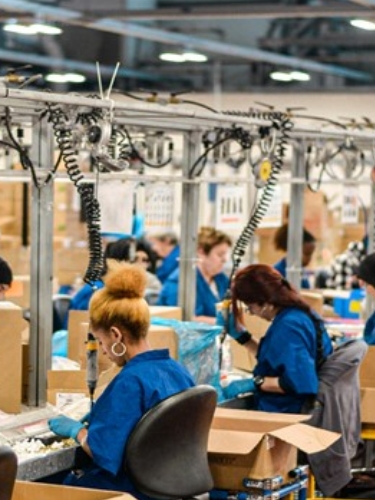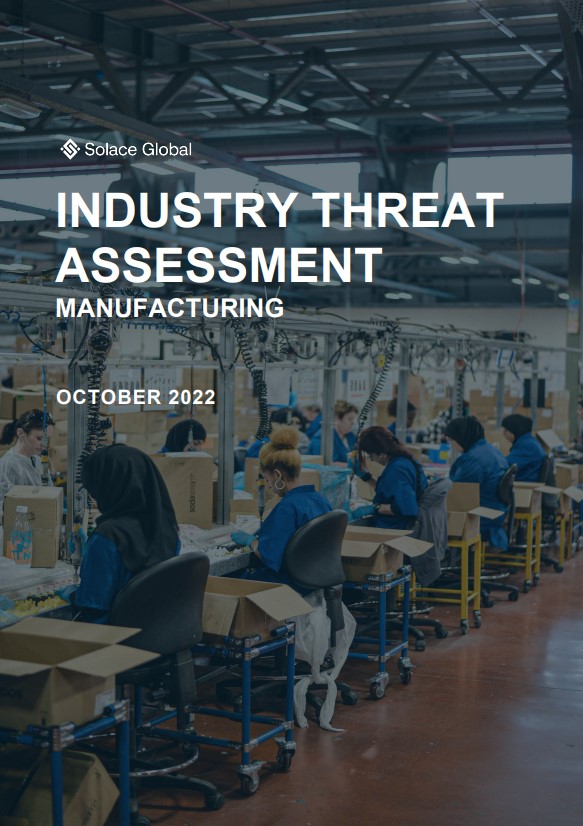Evacuations from High-Risk Locations Call +44 (0)1202 308810 or Contact Us →

Manufacturing Industry Threat Assessment
Since the advent of the COVID-19 pandemic, manufacturers have been subjected to a variety of shocks at the global, national, and local levels. This report examines the repercussions of these shocks and provides a forward-looking overview of the potential risk factors likely to impact manufacturing operations in the future. Global and industry-specific risk factors are examined, providing a comprehensive assessment of the threats that manufacturers may encounter over the short-to-medium term.
It remains the case that a series of converging crises hold the potential to compound upon one another, creating potentially damaging conditions for manufacturers to operate within. These risks should be identified, evaluated, and mitigated by all manufacturers as part of their due diligence processes and duty of care.
Executive Summary
Since the advent of the COVID-19 pandemic, manufacturers have been subjected to a variety of shocks at the global, national, and local levels. This report examines the repercussions of these shocks and provides a forward-looking overview of the potential risk factors likely to impact manufacturing operations in the future. Global and industry-specific risk factors are examined, providing a comprehensive assessment of the threats that manufacturers may encounter over the short-to-medium term.
It remains the case that a series of converging crises hold the potential to compound upon one another, creating potentially damaging conditions for manufacturers to operate within. These risks should be identified, evaluated, and mitigated by all manufacturers as part of their due diligence processes and duty of care.
2022 Manufacturing Review
Global manufacturing has thus far experienced a decline in 2022. The Manufacturing Purchasing Managers’ Index (PMI), compiled by S&P Global, has documented a sustained three-month fall in global manufacturing production to two-year lows. PMI scores of 51.1, 50.3, and 29.8 have been recorded in July, August, and September respectively, with any mark below 50 indicating a contraction on the previous month of manufacturing production. This fall in global manufacturing has been spearheaded by a confluence of crises and has been documented across the world’s major manufacturing hubs. China has experienced a reduced rate of expansion, whilst the United States, Eurozone, United Kingdom, and Japan have all undergone minimal expansion or decreases in manufacturing output under the PMI measurement.
The twin crises of the 2020-21 period, notably the COVID-19 pandemic and disrupted supply chains, have converged with new shocks to the global economy in 2022 to place downwards pressure on global manufacturing demand. Elevated gas and oil prices have fed into a surge in global inflation that was initially driven by a large increase in economic demand in 2021, as countries across the world began to reopen their economies following the lockdowns and other restrictive measures implemented during the COVID-19 pandemic.
Consequently, an increase in global manufacturing was documented during 2021. However, the continued presence of elevated inflation rates compared to recent historical levels in many of the world’s largest economies and markets has begun to reduce demand in 2022, as the price of goods increases further still. Russia’s ongoing invasion of Ukraine since February 2022 has further exacerbated these issues, with Western nations responding with sanction measures against the Russian economy, to subdue the Russian war effort by restricting its access to financing and, in the longer term, materiel. Russia’s decision to retaliate to Western sanctions by reducing its supply of gas to Europe has increased energy prices further, and therefore helped to increase the cost of manufacturing, particularly for energy intensive goods, both in the Eurozone and further abroad.
Other consequences of the Russian invasion of Ukraine include a shock to global food supply chains, particularly in wheat, grains, and cereals, where Ukraine and Russia constitute two of the largest exporters in the world. This has compounded existing upward pressures on global food prices, which the UN’s Food and Agricultural Organisation documented at a 10-year high prior to the invasion. Subsequent agreements between Ukraine and Russia to reopen the Black Sea for commercial shipping focused on food exports have helped to ease the pressure on food prices, but the surge in prices has contributed to the reduction in demand for other non-essential goods as household budgets shrink worldwide, including manufacturing products.
Whilst most Western economies have rescinded restrictive measures from the COVID-19 pandemic which impeded the ability of their economies to respond to surges in demand, China has continued to pursue a ‘Zero COVID-19’ policy towards managing the risks of the pandemic. Intense lockdowns have been declared in China throughout 2022 which have impacted China’s manufacturing output and, consequently, PMI figures. These measures continue to disrupt the global economic supply chains of manufactured goods, with China accounting for 30 percent of the world’s total manufacturing output in 2021. As a result, shifts in China’s economic landscape triggered by lockdown measures can and do have cascading effects on the global economy.
These factors paint a broad picture of a manufacturing industry that is facing a series of crises on multiple fronts. Organisations such as the World Bank have begun to revise predictions of global economic growth in 2022, forecasting significantly lower rates of growth than initially anticipated in January 2022. Other institutions such as the International Monetary Fund (IMF) are even highlighting the potential for a global recession, whilst national recessions are anticipated in many of the world’s top manufacturing producers, particularly in the UK and the Eurozone. These headwinds may yet subside through coordinated changes in fiscal, monetary, climate, and debt policy or by the alleviation of the pressures currently suppressing the global economy, but current forecasts suggest that Q4 2022 and beyond will be a turbulent period in which manufacturers will need to cautiously navigate a confluence of both pre-existing and potential risks.
Key Points
- New COVID-19 variants
- Shocks to energy supplies
- Geopolitical competition
- Cyber security threats
- Political risk and policy response
- Comments from Solace Global
